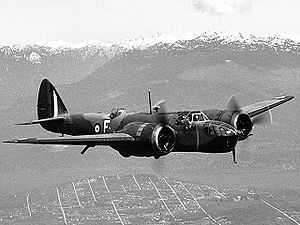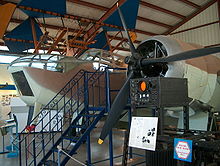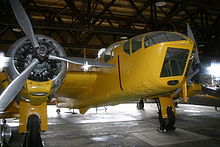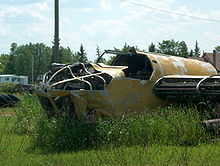Bristol Fairchild Bolingbroke Video - Movie clip
|
|
Bristol Fairchild Bolingbroke
Bolingbroke

Picture - Bolingbroke
Role: Maritime patrol aircraft
Manufacturer: Bristol Aeroplane Company
Fairchild Aircraft Ltd. (Canada)
First flight: 14 September 1939
Introduction: 15 November 1939
Primary user: Royal Canadian Air Force
Produced: 1939-1943
Number built: 626
Developed from: Bristol Blenheim
The Bristol Fairchild Bolingbroke was a maritime patrol aircraft for use the Royal Canadian Air Force. Built by Fairchild-Canada, it was a variant of the Bristol Blenheim Mk IV bomber.
Design and development
In 1935, the British Air Ministry issued Specification G.24/35 to procure a coastal reconnaissance/light bomber to replace the Avro Anson. Bristol proposed the Type 149, based on its Blenheim Mk I, with Bristol Aquila engines to give greater range. While the Air Ministry rejected this proposal, a Blenheim Mk I, retaining its Mercury VIII engines, was converted as a Type 149 (Blenheim Mk III) for the general reconnaissance role. The nose was lengthened to provide more room for the bombardier, with the upper left surface of the nose being scooped out to maintain pilot visibility during takeoff and landing.
The longer range also fulfilled a Canadian requirement for a maritime patrol aircraft. Consequently, Fairchild Aircraft Ltd. (Canada) of Quebec started production of the Blenheim Mk IV as the Bolingbroke (the originally intended name for the Blenheim IV). This type was nicknamed the "Bolly". After a small run of aircraft constructed to British specifications, as the Bolingbroke Mk I, Fairchild switched production to the Bolingbroke Mk IV with Canadian and American instruments and equipment. These versions also included anti-icing boots and a dinghy. One of the early Mk IV variants was the Bolingbroke Mk IVW which was powered by two 825 hp (615 kW) Pratt & Whitney SB4G Twin Wasp Junior engines. Incapable of maintaining altitude on one engine, the normal bomb load was reduced to 500 pounds on these aircraft to compensate for the low engine power. Most of the 151 Mk IV's served in their intended role as patrol bombers on the Atlantic and Pacific coasts of Canada between 1940 and 1944. Two squadrons of these aircraft also served in Alaska during the Aleutians campaign. Another 457 were completed as the Bolingbroke Mk IVT trainer which saw extensive use in the BCATP. A total of 626 Bolingbrokes were produced.
Operational history

Picture - Bristol Bolingbroke (Blenheim) IV at the British Columbia Museum of Flight, Victoria, British Columbia
Variants
Bolingbroke Mk I
Twin-engine maritime patrol bomber aircraft, powered by two Bristol Mercury VIII radial piston engines, with British equipment. 18 built.
Bolingbroke Mk II
Conversion of fifth Mk I with US equipment - prototype of Mk IV.
Bolingbroke Mk III
Floatplane conversion of sixteenth Bolingbroke Mk I, with two Edo floats.
Bolingbroke Mk IV
Twin-engine maritime patrol bomber aircraft, equipped with anti-icing boots and a dinghy, also fitted with American and Canadian instruments and equipment, powered by two Bristol Mercury XV radial piston engines, 134 built.
Bolingbroke Mk IVW
Sub-version of Mk IV powered by two 825 hp (615 kW) Pratt & Whitney SB4G Twin Wasp Junior radial piston engines as contingency against possible shortages of Mercury engines. The Mk IVW's performance was below that of the Mk IV and the supply of the British engines was maintained so production returned to the Mk IV after only 15 aircraft were built.
Bolingbroke Mk IVC
Version of Mk IV with 900 hp (671 kW) Wright R-1820 Cyclone engines not requiring high octane fuel. One built.
Bolingbroke Mk IVT
Multi-purpose trainer aircraft. A total of 350 built powered by Mercury XV engines, followed by a further 107 powered by the low-octane fuel Mercury XX* engine, giving a total of 457 built, with a further 51 cancelled. 6 Mk IVT were converted to dual controls. A further 89 were converted to Mk IVTT Target Tug with the addition of winching gear in the rear cabin and target drogue storage in the bomb bay.
Operators
Canada
Royal Canadian Air Force
Operational Squadrons of the Home War Establishment (HWE):
No. 8 Squadron RCAF - Used Bolingbroke Mk I and Mk IV (Dec 40 - Aug 43)
No. 115 Squadron RCAF - Used Bolingbroke Mk I (Aug 41 to Dec 41) and Mk IV (Nov 41 to Aug 43)
No. 119 Squadron RCAF - Used Bolingbroke Mk I (Aug 40 - Aug 41), Mk IVW (Aug - Nov 41) and Mk IV (Nov 41 - Jun 42)
No. 147 Squadron RCAF - Used Bolingbroke Mk I and Mk IV (Jul 42 - Mar 44)
The following HWE squadrons only had small numbers of Bolingbrokes on strength:
No. 13 (OT) Squadron RCAF - Used Bolingbroke Mk IV (Oct 41 - Jun 42)
No. 121 (K) Squadron RCAF - Used Bolingbroke Mk IVTT (Target Tug) (Aug 42 - May 44)
No. 122 (K) Squadron RCAF - Used Bolingbroke Mk IVTT (Target Tug) (Aug 42 - Sep 45)
No. 163 (AC) Squadron RCAF - Used Bolingbroke Mk IV (Mar - Jun 43)
(BR)-Bomber Reconnaissance; (OT)-Operational Training; (K)-Auxiliary; (AC)-Army Co-operation
British Commonwealth Air Training Plan (BCATP)
Bombing and Gunnery Schools
No. 1 B&G School - Jarvis, Ontario, Used Bolingbroke IVT (Aug 40 - Feb 45)
No. 2 B&G School - Mossbank, Saskatchewan, Used Bolingbroke IVT (Oct 40 - Dec 44)
No. 3 B&G School - Macdonald, Manitoba, Used Anson, Battle, Bolingbroke IVT and Lysander, (Mar 41 - Feb 45)
No. 4 B&G School - Fingal, Ontario, Used Bolingbroke IVT (Nov 40 - Feb 45)
No. 5 B&G School - Dafoe, Saskatchewan, Used Bolingbroke IVT (Apr 41 - Feb 45)
No. 6 B&G School - Mountain View, Ontario, Used Bolingbroke IVT (Jun 41 - Post War)
No. 7 B&G School - Paulson, Manitoba, Used Bolingbroke IVT (Jun 41 - Feb 45)
No. 8 B&G School - Lethbridge, Alberta, Used Bolingbroke IVT (Oct 41 - Dec 44)
No. 9 B&G School - Mont-Joli, Quebec, Used Bolingbroke IVT (Dec 41 - Apr 45)
No. 10 B&G School - Mount Pleasant, Prince Edward Island, Used Bolingbroke IVT (Sep 43 - Jun 45)
No. 31 B&G School (RAF) - Picton, Ontario, Used Bolingbroke IVT (Apr 41 - Nov 44) - currently Picton Airport
Survivors

Picture - Bolingbroke IVT in the Commonwealth Air Training Plan Museum, Brandon, Manitoba
The Canadian Warplane Heritage Museum in Hamilton, Ontario has been rebuilding a Bolingbroke to what is hoped to be airworthy status. The Commonwealth Air Training Plan Museum in Brandon, Manitoba has restored the exterior of one Bolingbroke, painting it in the Air Training Plan yellow color. This particular aircraft is on display on the Trans-Canada Highway in Brandon. Another example is on display at the National Museum of Flight in Scotland, under restoration. Another was taken from the collection of Lynn Garrison in Calgary, Alberta and transferred to the United Kingdom where it was restored to flying condition.
Specifications (Bolingbroke Mk IV)
Data from War Planes of the Second World War: Volume Seven Bombers and Reconnaissance Aircraft
General characteristics

Picture - Bolingbroke in a Manitoba junk yard, 2006
Crew: 3
Length: 42 ft 9 in (13.03 m)
Wingspan: 56 ft 4 in (17.17 m)
Height: 9 ft 10 in (3.00 m)
Wing area: 469 ft² (43.6 m²)
Empty weight: 9,835 lb (4,470 kg)
Loaded weight: 13,750 lb (6,250 kg)
Useful load: lb (kg)
Max takeoff weight: 14,500 lb (6,591 kg)
Powerplant: 2x Bristol Mercury XV nine-cylinder air-cooled radial engine, 920 hp (685 kW)at 9,250 ft (2,820 m) each
Performance
Maximum speed: 250 knots (288 mph, 464 km/h) at 15,000 ft (4,570 m)
Cruise speed: 174 knots (200 mph, 322 km/h)
Range: 1,617 nm (1,860 mi, 2,995 km) at 170 mph (274 km/h)
Service ceiling: 27,000 ft (8,230 m)
Rate of climb: 1,480 ft/min (7.5 m/s)
Wing loading: 29.3 lb/ft² (143 kg/m²)
Power/mass: 0.14 hp/lb (0.24 kW/kg)
Armament
Guns: 1x fixed forward firing .303 in Browning machine gun and one .303 in Browning machine gun in power operated dorsal turret, alternately in the IVT, two Browning machine guns in a Boulton Paul Type C turret
Bombs: 2x 500 lb (230 kg) or 4 x 250 lb (114 kg) bombs
Related development
Bristol Blenheim
Bristol Beaufort
Bristol Beaufighter
Comparable aircraft
Douglas DB-7
Dornier Do 17
Heinkel He 111
LeO 451
Martin Maryland
Potez 630
PZL.37 ÅoÅ
Tupolev SB
Bibliography
Air Ministry Pilot's Notes: Blenheim. London: OHMS/Air Data Publications, 1939.
Air Ministry Pilot's Notes: Blenheim V. London: OHMS/Air Data Publications, 1942.
Barnes, C.H. Bristol Aircraft Since 1910. London: Putnam, 1970. ISBN 0-85177-804-6.
Boiten, T. Bristol Blenheim. London: The Crowood Press, 1998. ISBN 1-86126-115-2.
Bowyer, C. Bristol Blenheim. London: Ian Allen, 1984. ISBN 0-7110-1351-9.
Donald, David. The Complete Encyclopedia of World Aircraft. New York: Barnes & Noble, 1997. ISBN 0-7607-0592-5.
Green, William. War Planes of the Second World War: Volume Six Floatplanes. London:Macdonald, 1962.
Green, William. War Planes of the Second World War: Volume Seven Bombers and Reconnaissance Aircraft. London: Macdonald, 1967.
Griffin, J.A. Canadian Military Aircraft Serials & Photographs 1920 - 1968. Ottawa: Queen's Printer, Publication No. 69-2, 1969.
Keskinen, Kalevi et al. Suomen Ilmavoimien Historia 10, Bristol Blenheim (in Finnish). Loviisa, Finland: Painoyhtymx¤ Oy, 2004. ISBN 952-99432-1-0.
Jefford, C.G., RAF Squadrons. Shrewsbury, UK: Airlife Publishing, 2nd edition, 2001. ISBN 1-84037-141-2.
Lake, Jon. Blenheim Squadrons of World War II. London: Osprey Publishing, 1998. ISBN 1-85532-723-6.
Kostenuk, S. and J. Griffin. RCAF Squadron Histories and Aircraft: 1924-1968. Toronto: Samuel Stevens, Hakkert & Company, 1977. ISBN 0-88866-577-6.
Mackay, Ron. Bristol Blenheim in Action. Carrollton, Texas: Squadron/Signal Publications, 1998. ISBN 0-89747-209-8.
March, Daniel J., ed. British Warplanes of World War II. London: Aerospace, 1998. ISBN 1-874023-92-1.
Marttila, Jukka. Bristol Blenheim - Taitoa ja tekniikkaa (in Finnish). Vantaa, Finland: Blenimi-Publishing, 1989. ISBN 952-90017-0-3.
Mason, Francis K. The British Bomber Since 1914. London: Putnam Aeronautical Books, 1994. ISBN 0-85177-861-5.
Molson, Ken M. and Harold A. Taylor. Canadian Aircraft Since 1909. Stittsville, Ontario: Canada's Wings, Inc., 1982. ISBN 0-920002-11-0.
Mondey, David. The Hamlyn Concise Guide to American Aircraft of World War II. London: Aerospace Publishing Ltd, 1996. ISBN 0-7858-1361-6.
Thomas, A. Bristol Blenheim (Warpaint No. 26). London: Hall Park Books, 2000. ISBN 1-84176-289-X.
Vincent, Carl Canadian Aircraft of WWII (AviaDossier No. 1). Kitchener, Ontario: SkyGrid, 2009. ISBN 978-0-9780696-3-6.
Warner, G. The Bristol Blenheim: A Complete History. London: Crécy Publishing, 2nd edition 2005. ISBN 0-85979-101-7.
Bristol Fairchild Bolingbroke Pictures
Living Warbirds: The best warbirds DVD series.
Source: WikiPedia